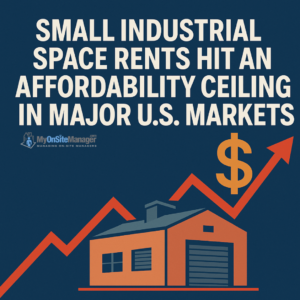In the race for real estate, industrial properties have quietly emerged as one of the most competitive and expensive sectors—especially for small bay warehouse spaces in urban markets. These smaller industrial units, typically under 50,000 square feet, have long served as the backbone for local businesses, tradespeople, manufacturers, and last-mile logistics providers. But now, many of these tenants are being priced out of the very locations they once called home.
A recent CoStar report reveals that rents for small industrial spaces have skyrocketed, particularly in already expensive metros like Los Angeles, San Francisco, Orange County, and Seattle. In Los Angeles alone, the average rent for small industrial properties has more than doubled in the last decade, far outpacing inflation and revenue growth for many small tenants.
Why the Spike in Rents?
The industrial real estate sector has evolved significantly in the past 10 years. While much of the attention has been placed on large fulfillment centers and logistics megahubs, small bay properties have been largely overlooked by developers. The result? A widening supply-demand imbalance.
Here’s what’s driving the surge in pricing:
Chronic Underdevelopment
Developers have focused almost exclusively on large-format warehouses in suburban and exurban areas, driven by the rise of e-commerce giants like Amazon. Meanwhile, construction of small bay industrial space—particularly in urban infill areas—has stagnated, leading to an aging inventory and near-zero vacancy in key regions.
Surging Demand from Urban Logistics
With growing consumer expectations for same-day and next-day delivery, companies are desperate for last-mile distribution points located near dense urban centers. Small bay warehouses offer exactly that—but there aren’t enough of them.
Low Turnover and Long Tenure
Small bay tenants, often mom-and-pop businesses, tend to stay for many years. As leases come up for renewal, landlords are capitalizing on high demand by raising rents significantly—sometimes by 20–30% or more.
Repurposing Pressure
In many major metros, industrial land is being rezoned or redeveloped into multifamily or commercial space. This has further reduced the pool of available small industrial space, creating intense competition for what remains.
The Affordability Ceiling: A Breaking Point for Small Businesses
Small tenants are now facing a hard truth: they simply can’t afford to operate in the same spaces they’ve occupied for decades. When rents were manageable, small bay properties allowed local businesses to thrive near their customer base. Now, many are being forced to make tough choices:
-
Relocate to fringe markets far from customers and suppliers
-
Downsize operations, sacrificing storage or work space
-
Exit urban markets entirely, or in worst cases, shut down
In Southern California, for example, monthly lease rates for a 10,000-square-foot warehouse can exceed $20,000, not including property taxes, insurance, and maintenance. For many businesses with tight margins, this is simply unsustainable.
What Does This Mean for the Broader Economy?
The health of small businesses is closely tied to the health of the broader economy. As the affordability of small industrial space diminishes, we risk weakening an essential tier of our economic ecosystem—especially in sectors like:
-
Construction and skilled trades
-
Custom manufacturing and artisanship
-
Food production and catering
-
Local e-commerce and last-mile delivery
When these businesses are displaced or unable to grow, the economic ripple effects are felt in lost jobs, reduced service coverage, and diminished community character.
What Can Be Done?
To address this growing crisis, stakeholders will need to take deliberate action. Some possibilities include:
- Encouraging redevelopment of older industrial buildings into modern small bay facilities with flexible lease terms
- Zoning reform to protect industrial-use land and prevent further displacement by residential or commercial conversions
- Incentives for developers to build smaller industrial footprints in urban and near-urban areas
- Public-private partnerships that reserve industrial space for community-serving businesses
Final Thoughts
Small bay industrial space has long been the unsung hero of the American city—powering businesses, building careers, and fueling local economies. But as rents soar and supply remains constrained, these essential spaces are now under threat. Without strategic action, we risk eroding the very infrastructure that supports small business growth.
The time to rethink how we prioritize and protect industrial space is now.
Source:
CoStar: Rents for Small Industrial Spaces Hit Affordability Ceiling in the Most Expensive US Markets

